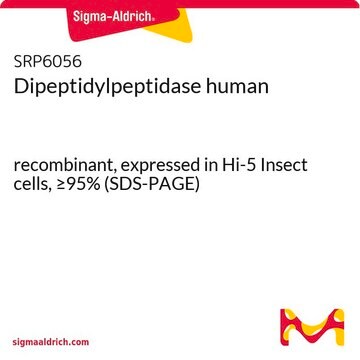317640-M
Dipeptidyl Peptidase IV (CD26), Porcine Kidney
Synonyme(s) :
CD26, DPPIV
Se connecterpour consulter vos tarifs contractuels et ceux de votre entreprise/organisme
About This Item
Produits recommandés
Pureté
≥90% (SDS-PAGE)
Niveau de qualité
Forme
liquid
Activité spécifique
≥35 units/mg protein
Fabricant/nom de marque
Calbiochem®
Conditions de stockage
OK to freeze
avoid repeated freeze/thaw cycles
Température de stockage
−70°C
Description générale
Native, DPP IV purified from porcine kidney (renal brush border of the proximal tubule). A serine exopeptidase dimer composed of two identical subunits of 110-130 kDa. Cleaves Xaa-Pro dipeptides from the N-terminus of oligo and polypeptides. DPPIV is involved in many cellular processes such as activation of cytokines, differentiation, T cell activation, and cell-matrix interactions. Inhibition of DPPIV has been reported to be an effective treatment for type II diabetes. MW: ~210000-260000 (unreduced).
Conditionnement
Please refer to vial label for lot-specific concentration.
Avertissement
Toxicity: Standard Handling (A)
Définition de l'unité
One unit is defined as the amount of enzyme that will hydrolyze 1.0 µmole 7-(Gly-Pro)-amino-4-methylcoumarinamide per min at 37°C, pH 8.5.
Forme physique
In 20 mM Tris-HCl, 5 mM CaCl₂, 1 µM ZnCl₂, 0.05% NaN₃, pH 8.0.
Reconstitution
Dilute only the amount of enzyme needed for each assay. Upon thawing, do not re-freeze, store in the refrigerator (4°C).
Autres remarques
Bar, J., et al. 2003. Biol. Chem.384, 1553.
Engel, M., et al. 2003. Proc. Natl. Acad. Sci. USA100, 5063.
Ikehara, Y., et al. 1994. Methods. Enzymol.244, 215.
David, F., et al. 1993. J. Biol. Chem.268, 17247.
Thomsen, P.D., et al. 1993. Mamm. Genome4, 604.
Misumi, Y., et al. 1992. Biochim. Biophys. Acta.1131, 333.
Seidl, R., et al. 1991. Biol. Chem. Hoppe Seyler372, 213.
Checler, F., et al. 1985. J. Neurochem.45, 1509.
Imai, K., et al. 1983. J. Biochem.93, 431.
Kato, T., et al. 1979. Experientia.35, 409.
Kojima, K., et al. 1979. Anal. Biochem.100, 43.
Kato, T., et al. 1978. Biochem. Med.19, 351.
Kenny, A.J., et al. 1976. Biochem. J.157, 169.
Engel, M., et al. 2003. Proc. Natl. Acad. Sci. USA100, 5063.
Ikehara, Y., et al. 1994. Methods. Enzymol.244, 215.
David, F., et al. 1993. J. Biol. Chem.268, 17247.
Thomsen, P.D., et al. 1993. Mamm. Genome4, 604.
Misumi, Y., et al. 1992. Biochim. Biophys. Acta.1131, 333.
Seidl, R., et al. 1991. Biol. Chem. Hoppe Seyler372, 213.
Checler, F., et al. 1985. J. Neurochem.45, 1509.
Imai, K., et al. 1983. J. Biochem.93, 431.
Kato, T., et al. 1979. Experientia.35, 409.
Kojima, K., et al. 1979. Anal. Biochem.100, 43.
Kato, T., et al. 1978. Biochem. Med.19, 351.
Kenny, A.J., et al. 1976. Biochem. J.157, 169.
Informations légales
CALBIOCHEM is a registered trademark of Merck KGaA, Darmstadt, Germany
Code de la classe de stockage
12 - Non Combustible Liquids
Classe de danger pour l'eau (WGK)
WGK 2
Point d'éclair (°F)
Not applicable
Point d'éclair (°C)
Not applicable
Certificats d'analyse (COA)
Recherchez un Certificats d'analyse (COA) en saisissant le numéro de lot du produit. Les numéros de lot figurent sur l'étiquette du produit après les mots "Lot" ou "Batch".
Déjà en possession de ce produit ?
Retrouvez la documentation relative aux produits que vous avez récemment achetés dans la Bibliothèque de documents.
Notre équipe de scientifiques dispose d'une expérience dans tous les secteurs de la recherche, notamment en sciences de la vie, science des matériaux, synthèse chimique, chromatographie, analyse et dans de nombreux autres domaines..
Contacter notre Service technique






